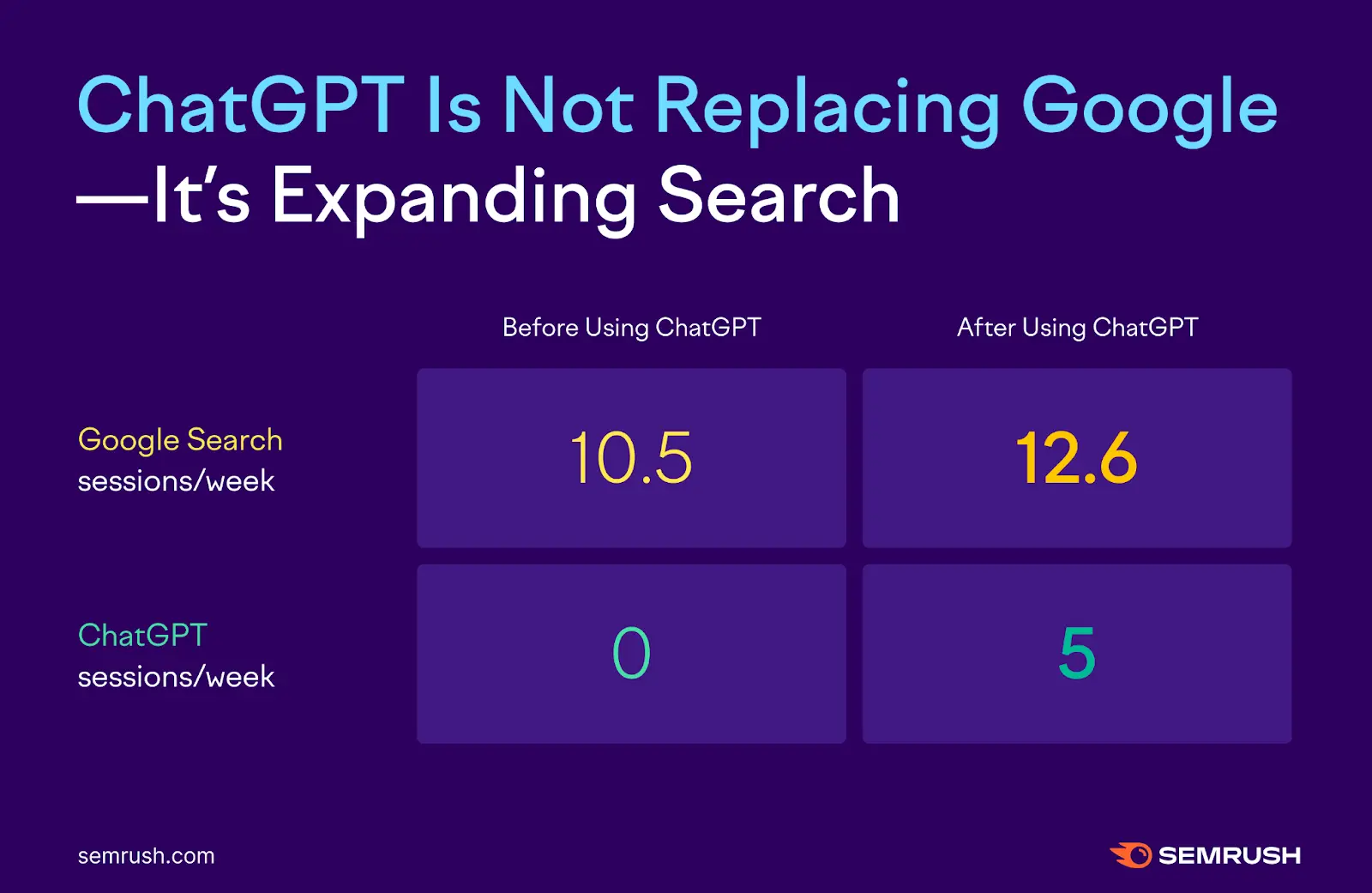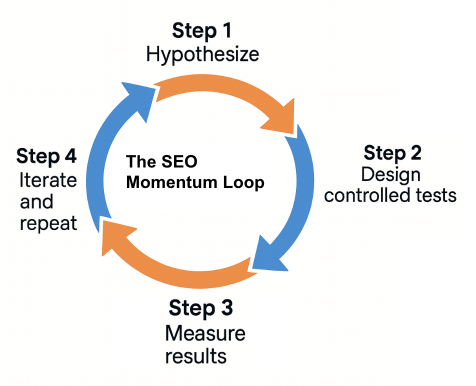
The current SEO world is louder than ever.
Depending on who you ask, SEO “died” in 2006, 2009, 2018; or maybe it’s scheduled for 2057. It’s hard to keep track. And then there’s the acronym soup designed to upsell the unsuspecting customer: LLM SEO, AEO, GEO, SGE, AEIOU (and sometimes Y!). But none of this noise really matters. Because in this world, there’s only one thing that consistently cuts through: testing.
SEO testing is the only reliable way to sustain success in today’s Google-first world, and to prepare for tomorrow’s AI-first future.
Traditional SEO used to lean heavily on playbooks: 2% keyword density, 157-character meta descriptions, keyword in the first 100 words, etc.

For a while, these rules appeared to work. But the cracks were always there. What helped one site rank might flop for another. A page that looked like it was built by Homer Simpson could still outrank a meticulously crafted $100k website.
Today, in the LLM era, “best practices” are more fragile than ever. They aren’t laws of success, they’re hypotheses at best.
And that’s exactly where testing steps in: to bridge the gap between what once seemed universal and what actually works for your site, in your niche.
Testing is how we move from guesswork to growth.
Here are some ideas below to get you started. Instead of following the “guru-of-the-week,” you get to find what really creates value for your site.
You should also check out the SEO testing case studies from search pilot.
The current SEO world is louder than ever.
Depending on who you ask, SEO “died” in 2006, 2009, 2018; or maybe it’s scheduled for 2057. It’s hard to keep track. And then there’s the acronym soup designed to upsell the unsuspecting customer: LLM SEO, AEO, GEO, SGE, AEIOU (and sometimes Y!). But none of this noise really matters. Because in this world, there’s only one thing that consistently cuts through: testing.
SEO testing is the only reliable way to sustain success in today’s Google-first world, and to prepare for tomorrow’s AI-first future.
Traditional SEO used to lean heavily on playbooks: 2% keyword density, 157-character meta descriptions, keyword in the first 100 words, etc.

For a while, these rules appeared to work. But the cracks were always there. What helped one site rank might flop for another. A page that looked like it was built by Homer Simpson could still outrank a meticulously crafted $100k website.
Today, in the LLM era, “best practices” are more fragile than ever. They aren’t laws of success, they’re hypotheses at best.
And that’s exactly where testing steps in: to bridge the gap between what once seemed universal and what actually works for your site, in your niche.
Testing is how we move from guesswork to growth.
Here are some ideas below to get you started. Instead of following the “guru-of-the-week,” you get to find what really creates value for your site.
You should also check out the SEO testing case studies from search pilot.
The current SEO world is louder than ever.
Depending on who you ask, SEO “died” in 2006, 2009, 2018; or maybe it’s scheduled for 2057. It’s hard to keep track. And then there’s the acronym soup designed to upsell the unsuspecting customer: LLM SEO, AEO, GEO, SGE, AEIOU (and sometimes Y!). But none of this noise really matters. Because in this world, there’s only one thing that consistently cuts through: testing.
SEO testing is the only reliable way to sustain success in today’s Google-first world, and to prepare for tomorrow’s AI-first future.
Traditional SEO used to lean heavily on playbooks: 2% keyword density, 157-character meta descriptions, keyword in the first 100 words, etc.

For a while, these rules appeared to work. But the cracks were always there. What helped one site rank might flop for another. A page that looked like it was built by Homer Simpson could still outrank a meticulously crafted $100k website.
Today, in the LLM era, “best practices” are more fragile than ever. They aren’t laws of success, they’re hypotheses at best.
And that’s exactly where testing steps in: to bridge the gap between what once seemed universal and what actually works for your site, in your niche.
Testing is how we move from guesswork to growth.
Here are some ideas below to get you started. Instead of following the “guru-of-the-week,” you get to find what really creates value for your site.
You should also check out the SEO testing case studies from search pilot.
The current SEO world is louder than ever.
Depending on who you ask, SEO “died” in 2006, 2009, 2018; or maybe it’s scheduled for 2057. It’s hard to keep track. And then there’s the acronym soup designed to upsell the unsuspecting customer: LLM SEO, AEO, GEO, SGE, AEIOU (and sometimes Y!). But none of this noise really matters. Because in this world, there’s only one thing that consistently cuts through: testing.
SEO testing is the only reliable way to sustain success in today’s Google-first world, and to prepare for tomorrow’s AI-first future.
Traditional SEO used to lean heavily on playbooks: 2% keyword density, 157-character meta descriptions, keyword in the first 100 words, etc.

For a while, these rules appeared to work. But the cracks were always there. What helped one site rank might flop for another. A page that looked like it was built by Homer Simpson could still outrank a meticulously crafted $100k website.
Today, in the LLM era, “best practices” are more fragile than ever. They aren’t laws of success, they’re hypotheses at best.
And that’s exactly where testing steps in: to bridge the gap between what once seemed universal and what actually works for your site, in your niche.
Testing is how we move from guesswork to growth.
Here are some ideas below to get you started. Instead of following the “guru-of-the-week,” you get to find what really creates value for your site.
You should also check out the SEO testing case studies from search pilot.
Now: Google remains the foundation. With ~90% market share, and ~41% of traffic referral, search rankings still drive the majority of traffic and revenue. Ignoring that reality today would be reckless.
Data from Sparktoro and Datos showed how much AI tools have grown.
However, within the data, the bigger story was how little traditional search declined, holding at 95% for desktop users.

Pair that with SEMrush research showing users increasing their Google searches before and after using ChatGPT, and the picture is clear: AI isn’t replacing search (yet?), it’s reinforcing it.

Next: AI-driven discovery is accelerating. ChatGPT, Perplexity, and Google’s AI Mode are reshaping how people find and consume information. Ignoring this shift would be just as shortsighted.
Testing is the Bridge that lets you win in both worlds.
So, while LinkedIn warriors debate acronyms, the real advantage comes from testing. Staying anchored in the present without losing sight of the future.
Why AI search changes the rules:
AI is shifting discovery from ranking pages to retrieving answers. Context now matters more than individual keywords, and citations matter more than traditional search positions. The takeaway: test and validate this for yourself.
The role of entities and structure
Entities, schema, and semantic alignment give AI systems clarity. Structured data signals who you are, what you do, and why you’re relevant, helping content surface consistently (or does it?).
The new testing frontier
SEO teams must now test and measure for how content is cited in AI outputs:
Concrete examples:
No shortcuts, only testing
There are no universal “AI SEO” playbooks. The only way to know what works in the new landscape is to do it yourself.
Success in SEO doesn’t come from one big breakthrough, but from a system that keeps learning and adapting. The momentum loop captures this process: a self-reinforcing loop where each experiment fuels the next. Instead of chasing silver bullets, you build compounding advantages with faster insights, smarter decisions, and steady growth that never stalls.

Each test sharpens your strategy, compounding insights into momentum that competitors can’t match. You can run multiple experiments in parallel, and because the loop never stops, your site continually evolves through ongoing iterations and implementations.
SEO isn’t dead, best practices are dying and guessing won’t scale. The only durable moat in SEO is testing.
If you’re not testing, you’re guessing, and guessing won’t survive the shift from Google rankings to AI retrieval.
The winners will be those who capture traffic now, test relentlessly for what’s next, and build a culture where SEO is synonymous with experimentation.
The current SEO world is louder than ever.
Depending on who you ask, SEO “died” in 2006, 2009, 2018; or maybe it’s scheduled for 2057. It’s hard to keep track. And then there’s the acronym soup designed to upsell the unsuspecting customer: LLM SEO, AEO, GEO, SGE, AEIOU (and sometimes Y!). But none of this noise really matters. Because in this world, there’s only one thing that consistently cuts through: testing.
SEO testing is the only reliable way to sustain success in today’s Google-first world, and to prepare for tomorrow’s AI-first future.
Traditional SEO used to lean heavily on playbooks: 2% keyword density, 157-character meta descriptions, keyword in the first 100 words, etc.

For a while, these rules appeared to work. But the cracks were always there. What helped one site rank might flop for another. A page that looked like it was built by Homer Simpson could still outrank a meticulously crafted $100k website.
Today, in the LLM era, “best practices” are more fragile than ever. They aren’t laws of success, they’re hypotheses at best.
And that’s exactly where testing steps in: to bridge the gap between what once seemed universal and what actually works for your site, in your niche.
Testing is how we move from guesswork to growth.
Here are some ideas below to get you started. Instead of following the “guru-of-the-week,” you get to find what really creates value for your site.
You should also check out the SEO testing case studies from search pilot.
Let’s say a buyer asks AI: “What is injection molding?”
An LLM will typically fan out into multiple sub-questions, such as:
Now: Google remains the foundation. With ~90% market share, and ~41% of traffic referral, search rankings still drive the majority of traffic and revenue. Ignoring that reality today would be reckless.
Data from Sparktoro and Datos showed how much AI tools have grown.
However, within the data, the bigger story was how little traditional search declined, holding at 95% for desktop users.

Pair that with SEMrush research showing users increasing their Google searches before and after using ChatGPT, and the picture is clear: AI isn’t replacing search (yet?), it’s reinforcing it.

Next: AI-driven discovery is accelerating. ChatGPT, Perplexity, and Google’s AI Mode are reshaping how people find and consume information. Ignoring this shift would be just as shortsighted.
Testing is the Bridge that lets you win in both worlds.
So, while LinkedIn warriors debate acronyms, the real advantage comes from testing. Staying anchored in the present without losing sight of the future.
Why AI search changes the rules:
AI is shifting discovery from ranking pages to retrieving answers. Context now matters more than individual keywords, and citations matter more than traditional search positions. The takeaway: test and validate this for yourself.
The role of entities and structure
Entities, schema, and semantic alignment give AI systems clarity. Structured data signals who you are, what you do, and why you’re relevant, helping content surface consistently (or does it?).
The new testing frontier
SEO teams must now test and measure for how content is cited in AI outputs:
Concrete examples:
No shortcuts, only testing
There are no universal “AI SEO” playbooks. The only way to know what works in the new landscape is to do it yourself.
Success in SEO doesn’t come from one big breakthrough, but from a system that keeps learning and adapting. The momentum loop captures this process: a self-reinforcing loop where each experiment fuels the next. Instead of chasing silver bullets, you build compounding advantages with faster insights, smarter decisions, and steady growth that never stalls.

Each test sharpens your strategy, compounding insights into momentum that competitors can’t match. You can run multiple experiments in parallel, and because the loop never stops, your site continually evolves through ongoing iterations and implementations.
SEO isn’t dead, best practices are dying and guessing won’t scale. The only durable moat in SEO is testing.
If you’re not testing, you’re guessing, and guessing won’t survive the shift from Google rankings to AI retrieval.
The winners will be those who capture traffic now, test relentlessly for what’s next, and build a culture where SEO is synonymous with experimentation.
Cover all stages: